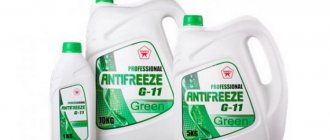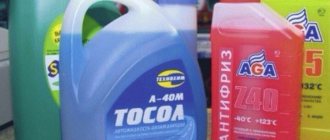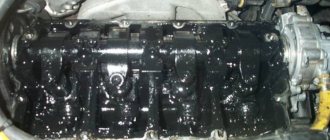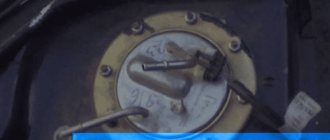In the summer, in cities and beyond, you can often see “boiling” cars. It often turns out that the engine began to knock due to a clogged radiator or a failed pump. In this case, one can only sympathize with the person who has to pay a decent amount for engine repairs only because he forgot that it is necessary to change the antifreeze in the car on time. In this article we will talk about when you should do this and what “alarm bells” can warn you about the risk.
Why change antifreeze
When the engine is running, the coolant continuously circulates through special channels, taking and transferring the heat generated from the operation of the internal combustion engine. If this process malfunctions, the engine will begin to overheat, which will lead to severe wear and serious malfunctions.
For example, if the internal combustion engine overheats, it may seize, which will require expensive and complex repairs.
We detect loss of refrigerant properties
There are some parameters by which you can determine how long it is time to replace antifreeze:
- cloudy color;
- sediments in the form of rust, foam, scale particles and other formations in the liquid;
- decrease in coolant level.
If you find at least one point in the tank, you should understand that it’s time to worry about changing the antifreeze.
One of the most effective methods for determining the quality of coolant is the use of special test strips, which, when immersed in a tank of antifreeze, acquire a certain shade.
Main problems
Many car owners, especially beginners, believe that there is nothing wrong with rarely replacing the coolant. That it doesn’t need to be changed at all, and that all the unpleasant stories associated with this procedure are a myth or a marketing ploy to increase sales of antifreeze.
Of course, if you replace the refrigerant with a slight delay, then there will be no major problems with the engine. However, there may be malfunctions that are not so noticeable, but can cause certain troubles.
The most common problems are
Overheat. The normal operating temperature of the engine varies from 85 to 90°C. The clearances and materials used to manufacture the power unit parts are designed for this mode.
- Strong overheating expands the elements, which leads to jamming, weaker overheating leads to a decrease in power and an increase in fuel consumption.
- Insufficient cooling causes deformation of the piston rings and cylinders, which increases the gaps in the compression and oil rings.
This problem leads to the penetration of exhaust gases into lubricants and the exhaust manifold. Operating an internal combustion engine at elevated temperatures reduces its service life by up to three times.
Corrosion
The coolant contains some water, approximately 5%. The refrigerant itself has increased hygroscopicity, which means its ability to absorb moisture even when in contact with air.
- As a result, the moisture contained in antifreeze provokes corrosion.
- Oxidation of the surfaces inside the radiator and the entire line reduces the performance of the vehicle's cooling system.
- Also, the corrosive layer increases the load on the internal combustion engine.
Precipitation
Silicate-based antifreeze contains substances that, over time, precipitate into microscopic particles of silicon. Moving along the cooling system lines, they scratch the internal surfaces.
Cavitation
A physical process in which bubbles (cavities, voids) appear in a heated liquid. When they burst, they release a large amount of energy, creating excess pressure in the car’s cooling system.
In addition, during this process, metal surfaces are destroyed, which can lead to leaks.
Freezing
The increased hygroscopicity of the cooling composition regularly increases the amount of moisture concentration, which gradually deprives the antifreeze of its antifreeze properties. When water crystallizes, the liquid expands, which can cause any element of the cooling system to fail.
Useful tips
Let's summarize the information about replacing antifreeze:
- add the liquid that is already filled into the system - the ideal solution is the composition recommended by the manufacturer;
- do not focus only on the color of the antifreeze - the shade itself cannot provide a complete guarantee that the antifreeze is of one type or another;
- do not mix compounds with different technical properties - this will provoke cavitation processes, metal corrosion will begin, which will inevitably lead to engine overheating.
And be sure to pour new fluid into the tank as slowly as possible, using a funnel - if the stream is strong, air will enter the system.
Every driver can replace antifreeze in his car, regardless of experience. On the other hand, he must know how often to do this, act strictly according to the instructions, thoroughly flush the system and refill with the recommended compounds. Recently, many people entrust this operation to service centers, since they do not have enough time to do the work themselves.
Frequency of antifreeze replacement
Knowing the possible problems, we can conclude that it is simply necessary to change the antifreeze.
How often to do this depends on:
- Type of liquid used;
- Mileage;
- Car brands.
The approximate frequency of refrigerant replacement is as follows:
- Antifreeze and antifreeze G11 are designed for two years of service and require changing the fluid after 9000 km;
- G12 series with a five-year service life - 150,000 km;
- Multifreeze lasts up to ten years, replacement after 250,000 km.
Professionals do not advise relying entirely on the instructions of automakers, where the recommendations are based on average data. They most often do not take into account:
- Vehicle operating conditions;
- The quality of its maintenance;
- Condition of the cooling system at the time of fluid change.
Antifreeze and category G11
Standard type antifreezes that do not contain organics. More often they contain various additives.
- They are mainly poured into systems of older car models or those with an internal combustion engine cylinder block made of cast iron or aluminum alloys.
- These fluids are replaced after approximately 50,000–75,000 km.
Class G12
Liquids containing salts of carboxylic acids and organic additives. Ethylene glycol is used as their basis.
- It also contains carboxylic acid.
- The refrigerant should be replaced after 120,000 km.
Hybrid formulations
They got their name because they contain both inorganic and organic substances.
- They have all the best qualities inherent in the above-described compositions, and therefore are more effective.
- The replacement frequency is from 90,000 to 120,000 km.
Non-standard standards
Unlike many other automotive technical fluids, there are practically no global standards for coolants. There are domestic outdated GOST, national standards of the USA, Japan, France and other countries.
Moreover, they do not determine the composition of the liquid (this is a trade secret!), but list only the required characteristics - density, temperature at which crystals appear, interaction with metals, rubber, etc. Large automakers also have their own specifications. Thus, Volkswagen standards have become almost universally accepted (G11, G12, G13).
List of antifreeze standards:
- G11 - coolants created using traditional (silicate) technology; inorganic silicates are used as additives together with various combinations of salts of inorganic acids;
- G12 - they do not contain inorganic compounds characteristic of silicate antifreezes;
- G12+ is a hybrid production technology combining silicates and organic acids;
- G12++ - these antifreezes occupy an intermediate position between hybrid and carboxylate;
- G13 - toxic ethylene glycol base, replaced with harmless and “environmentally friendly” glycerin or propylene glycol;
- G48 - silicate type, analogue of G11 antifreeze;
- G30, G33 and G34 - carboxylate type, complete analogue of G12;
- G05 - analogue of the European G12+;
- G40 is an analogue of the European G12++.
We recommend reading the article about the 8 best G12 class antifreezes.
There is a video waiting for you at the very end of the article!
Lobrid formulations
Low hybrid liquids. They are often labeled as G13-classified coolants. They have a composition that is significantly different from all other similar products.
They are based predominantly on propylene glycol. They are the safest for the cooling system. They need replacement very rarely after about 250,000 km.
Precautionary measures
Do not pour liquid into a cooling system with holes. Before filling, you need to check the reliability of the system and rinse it with clean water.
Do not fill the tank to the top - antifreeze can occupy no more than 90% of the total volume.
Do not allow oil, diesel fuel and gasoline to get into the coolant.
The main storage condition is clean containers without foreign inclusions.
Low-freezing fluids prevent damage to parts due to less expansion. When freezing, ordinary water expands in volume by 9%, while a mixture with dihydric alcohol can expand three times less. Antifreeze protects the engine system from overheating and freezing.
Replacement
Before you start replacing antifreeze, you need to read the vehicle maintenance documents.
This procedure is identical on most cars:
- Purchase a suitable liquid.
- Place the vehicle on a level surface.
- Allow the engine to cool completely.
- Place a suitable container under the radiator to drain used antifreeze.
- Unscrew the drain cap
- Drain the remaining refrigerant from the expansion tank.
- Flush the system with a special compound.
- Fill with fresh antifreeze, focusing on the mark on the expansion tank.
There is no doubt that replacing the refrigerant, but you need to choose its frequency based on the manufacturer’s recommendations and the operating characteristics of the car.











